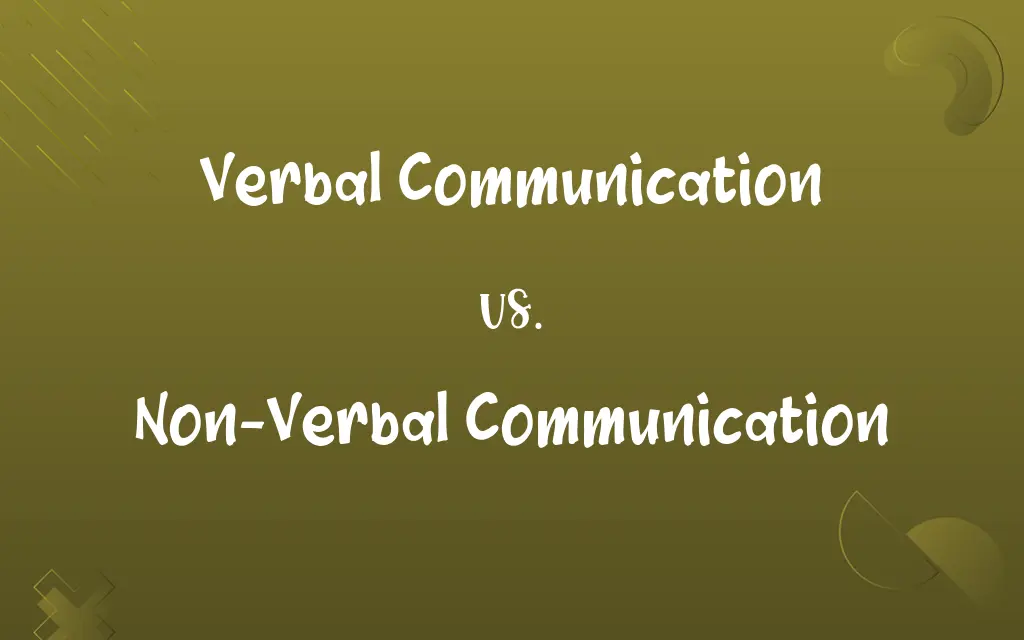Verbal Communication vs. Non-Verbal Communication: Know the Difference

By Shumaila Saeed || Published on February 21, 2024
Verbal communication involves spoken or written language, while non-verbal communication includes gestures, facial expressions, and body language.

Key Differences
Verbal communication is the use of words, either spoken or written, to convey a message. Non-verbal communication, on the other hand, involves expressing thoughts and emotions without words, through body language, facial expressions, and gestures.
Shumaila Saeed
Feb 21, 2024
Verbal communication allows for clear articulation of ideas and can be direct and straightforward. Non-verbal communication often conveys emotions and attitudes more subtly, relying on visual cues rather than explicit statements.
Shumaila Saeed
Feb 21, 2024
In verbal communication, the meaning of a message is largely derived from the words used. In contrast, non-verbal communication relies heavily on context, such as tone of voice, posture, and facial expressions, to convey meaning.
Shumaila Saeed
Feb 21, 2024
Verbal communication can occur in person, over the phone, or in writing. Non-verbal communication, however, requires visual contact, as it is mostly about observing physical behavior and expressions.
Shumaila Saeed
Feb 21, 2024
While verbal communication is often premeditated and can be rehearsed, non-verbal communication is frequently instinctive and can reveal a person's true feelings, irrespective of their spoken words.
Shumaila Saeed
Feb 21, 2024
ADVERTISEMENT
Comparison Chart
Medium
Spoken or written language
Body language, facial expressions, gestures
Shumaila Saeed
Feb 21, 2024
Clarity and Directness
Can be clear and direct
Often subtle and open to interpretation
Shumaila Saeed
Feb 21, 2024
Dependency on Context
Less dependent on context
Highly dependent on visual and situational cues
Shumaila Saeed
Feb 21, 2024
Pre-meditation
Often premeditated and rehearsed
Usually instinctive and spontaneous
Shumaila Saeed
Feb 21, 2024
ADVERTISEMENT
Verbal Communication and Non-Verbal Communication Definitions
Verbal Communication
Verbal communication includes any form of message exchange using words.
The teacher's verbal communication skills made the lesson engaging.
Shumaila Saeed
Jan 25, 2024
Non-Verbal Communication
Non-verbal communication is the use of physical behavior to express feelings.
The firm handshake was a non-verbal communication of confidence.
Shumaila Saeed
Jan 25, 2024
Verbal Communication
Verbal communication is the articulation of thoughts through spoken language.
During the meeting, his verbal communication was clear and concise.
Shumaila Saeed
Jan 25, 2024
Non-Verbal Communication
Non-verbal communication includes facial expressions, gestures, and posture.
Her smile was a powerful non-verbal communication of her happiness.
Shumaila Saeed
Jan 25, 2024
Verbal Communication
Verbal communication involves speaking or writing to communicate messages.
She wrote an email to her team, an example of written verbal communication.
Shumaila Saeed
Jan 25, 2024
ADVERTISEMENT
Non-Verbal Communication
Non-verbal communication is the unspoken aspect of interaction.
Eye contact during the interview was an important non-verbal communication cue.
Shumaila Saeed
Jan 25, 2024
Verbal Communication
Verbal communication is the exchange of information using words.
He gave a speech to convey his ideas, using effective verbal communication.
Shumaila Saeed
Jan 25, 2024
Non-Verbal Communication
Non-verbal communication is expressing thoughts without words, using body language.
His crossed arms during the conversation were a form of non-verbal communication.
Shumaila Saeed
Jan 25, 2024
Verbal Communication
Verbal communication encompasses all word-based communication, whether oral or written.
The novel is an example of verbal communication in a written form.
Shumaila Saeed
Jan 25, 2024
Non-Verbal Communication
Non-verbal communication conveys emotions and reactions silently.
Nodding in agreement is a common form of non-verbal communication.
Shumaila Saeed
Jan 25, 2024
Repeatedly Asked Queries
What is non-verbal communication?
Non-verbal communication involves expressing thoughts without words, using body language and facial expressions.
Shumaila Saeed
Feb 21, 2024
How important is non-verbal communication?
Non-verbal communication is crucial as it often reveals true emotions and complements verbal communication.
Shumaila Saeed
Feb 21, 2024
How can one improve their verbal communication skills?
Improving verbal communication involves active listening, practicing articulation, and expanding vocabulary.
Shumaila Saeed
Feb 21, 2024
What is verbal communication?
Verbal communication is the use of spoken or written words to convey a message.
Shumaila Saeed
Feb 21, 2024
What are the potential drawbacks of verbal communication?
Disadvantages can include misinterpretation, misunderstanding, and the possibility of information being forgotten.
Shumaila Saeed
Feb 21, 2024
Is non-verbal communication always intentional?
No, sometimes non-verbal cues are subconscious and may not be deliberate.
Shumaila Saeed
Feb 21, 2024
Can verbal communication be misleading?
Yes, verbal communication can sometimes be misleading if words are not clear or are misinterpreted.
Shumaila Saeed
Feb 21, 2024
How does non-verbal communication impact interpersonal relationships?
It can convey trust, empathy, and sincerity or reveal discomfort, deceit, and insincerity.
Shumaila Saeed
Feb 21, 2024
Can non-verbal communication contradict verbal messages?
Yes, it is possible for non-verbal cues to contradict spoken words, leading to mixed messages.
Shumaila Saeed
Feb 21, 2024
Can verbal communication be both formal and informal?
Yes, verbal communication can be formal (e.g., professional meetings) or informal (e.g., casual conversations with friends).
Shumaila Saeed
Feb 21, 2024
Can non-verbal cues vary across cultures?
Yes, non-verbal communication is culturally influenced, and gestures and expressions can have different meanings in different cultures.
Shumaila Saeed
Feb 21, 2024
What is the role of tone in verbal communication?
Tone influences the way a message is perceived and can convey emotions or attitudes.
Shumaila Saeed
Feb 21, 2024
What are some common barriers to effective verbal communication?
Barriers can include language barriers, distractions, and differences in communication styles.
Shumaila Saeed
Feb 21, 2024
Can non-verbal communication be used in professional settings?
Yes, non-verbal communication is important in professional contexts, such as job interviews and business negotiations, to convey confidence and professionalism.
Shumaila Saeed
Feb 21, 2024
How can one become more aware of their non-verbal communication?
Increasing self-awareness and observing others' non-verbal cues can help improve awareness.
Shumaila Saeed
Feb 21, 2024
What are the challenges in interpreting non-verbal communication accurately?
Challenges include misinterpretation of cues and the influence of personal biases.
Shumaila Saeed
Feb 21, 2024
What are the advantages of verbal communication?
Advantages of verbal communication include clarity, precision, and the ability to convey complex ideas.
Shumaila Saeed
Feb 21, 2024
What are some examples of non-verbal communication cues?
Examples include eye contact, posture, hand gestures, facial expressions, and proxemics (personal space).
Shumaila Saeed
Feb 21, 2024
Share this page
Link for your blog / website
HTML
Link to share via messenger
About Author
Written by
Shumaila SaeedShumaila Saeed, an expert content creator with 6 years of experience, specializes in distilling complex topics into easily digestible comparisons, shining a light on the nuances that both inform and educate readers with clarity and accuracy.









































































